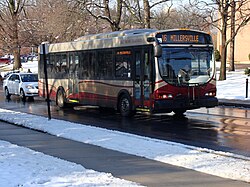 | |
| Formerly | Chance Coach Inc. (1976–2003) Optima Bus Corporation (2003-2007) |
|---|---|
| Industry | Bus manufacturing |
| Founded | 1976 (as Chance Coach Inc.) |
| Defunct | 2010 |
| Headquarters | |
| Products | Transit buses |
| Parent | American Capital Strategies (1998-2006) NABI, Inc. (2006-2010) |
| Website | www.optimabus.com (archived link) |
Optima Bus, LLC, formerly Chance Coach Inc., was a brand of small transit buses manufactured by North American Bus Industries. It was established in 1976 in Wichita, Kansas.
Contents
It was originally the trolley-replica and conventional bus production business of Chance Industries, Inc. In 1998, Chance Coach, Inc. was sold to American Capital Strategies, [1] which rebranded the company as Optima Bus Corporation in 2003. [2] American Capital subsequently sold Optima to North American Bus Industries, who closed the Kansas assembly plant on August 8, 2007, with production moved to their existing plant in Anniston, Alabama. [3] Optima Bus was owned by North American Bus Industries, Inc. [4] until 2010 when NABI discontinued the production of its Optima and Blue Bird brand commercial bus products.



